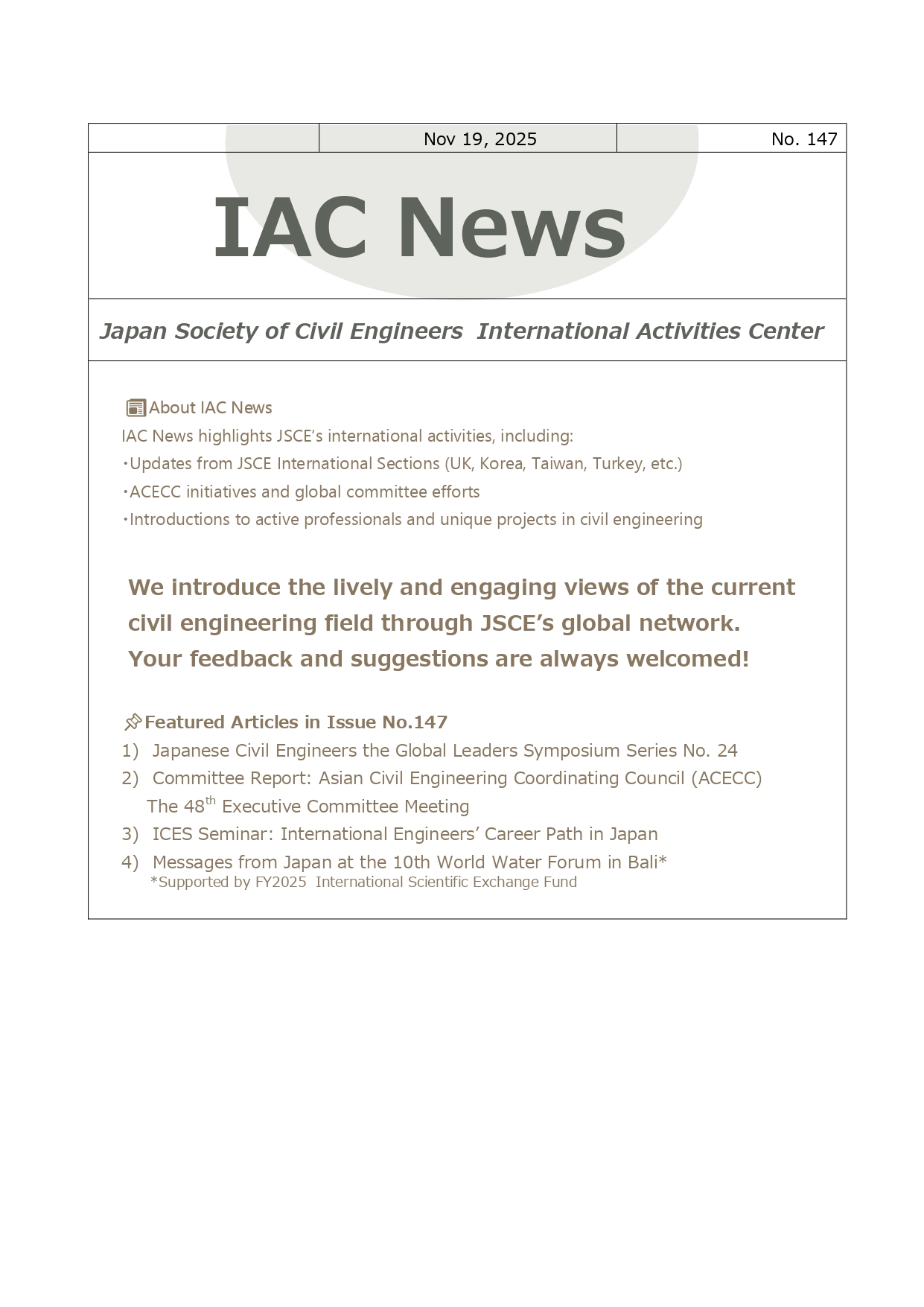2008 Outstanding Civil Engineering Achievement Award
[Group-1]
| 1. Realization of Ultra Short Term Construction of an Underground Structure and Development of a Bicycle Parking System Using IC Tags |
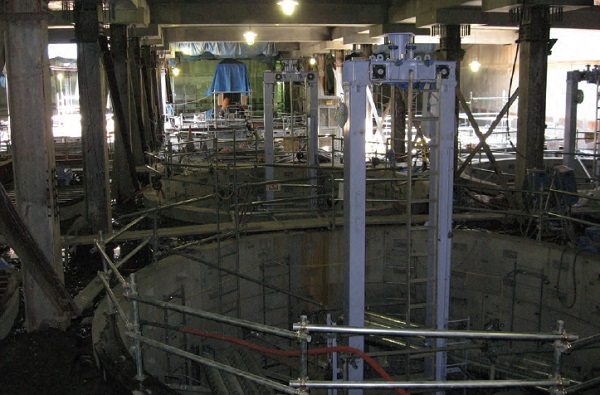 |
| ・Edogawa Ward Office |
|
This project aims at eliminating illegally-parked or abandoned bicycles around the Tokyo Metro Kasai Station and promoting a modal shift to environmentally-friendly vehicles like bicycles. |
| 2. Design and Construction Technologies for the Nation’s First Large Twin Tunnels Close to Existing Structures Passing Right Underneath Buildings - New Tomei Expressway Imasato Daiichi Tunnel - |
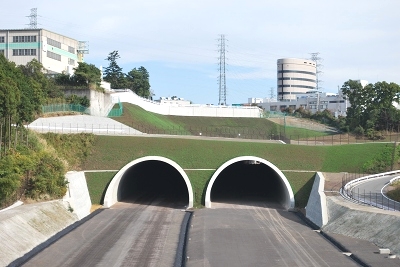 |
| ・Numazu Construction Office, Tokyo Branch, Central Nippon Expressway Co., Ltd. SHIMIZU Corp., Aisawa Construction Co., Ltd., P.S.Mitsubishi Construction Co., Ltd. Joint Venture |
| Imasato-Daiichi Tunnel is the twin parallel tunnels with a large cross section under small overburden which are located extremely close to existing structures. Concerning the construction of the tunnels, a lot of technical difficulties were anticipated due to buildings right above the tunnels. Thus, the design of high-strength support system and improvement of pillars between the tunnels with preceding grouting operations were made to assure mechanical stability. These innovations contributed to the successful construction of large twin tunnels very close to existing structures, which led to the establishment of design and construction methods for this kind of tunnels. |
| 3. Construction of Large Double Adjoined Binocular Tunnels Beneath a Densely Residential Area - Daini Keihan Expressway Shoji Tunnel Project - |
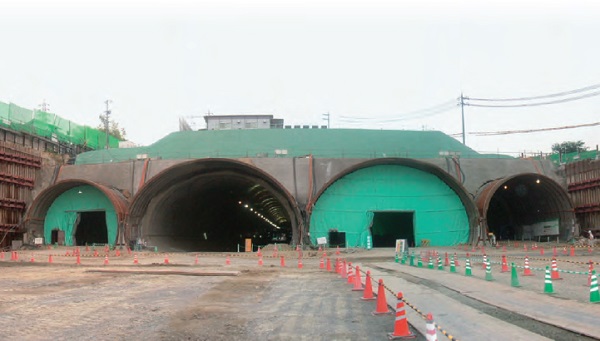 |
| ・West Nippon Expressway Company, Ltd. Hirakata Construction Office Joint Venture of TAISEI Corp., Hazama Corp. and Fukuda Corp. |
| Shoji Tunnel on Daini Keihan Expressway locates in the hilly terrain where residential houses are clustered densely. The tunnel is 265 m long and comprises four-linked tunnels of total width of 58 m: two on two 3-lane expressways and the other two on two 2-lane national highways. It is constructed under a severe condition of maximum 10.5 m overburden in an unconsolidated sandy ground. Several technologies were developed to alleviate environmental issues including noise and vibration control, ground subsidence control and groundwater flow preservation, to achieve designs based on three-dimensional numerical analysis and dynamic aseismic analysis, and to establish construction methods such as cement mixing soil improvement, chemical grouting and semi-selfcompacting concrete. |
| 4. Development of Tunneling Methods in Anomalous Grounds with Heavy Squeezing or High Groundwater Pressure |
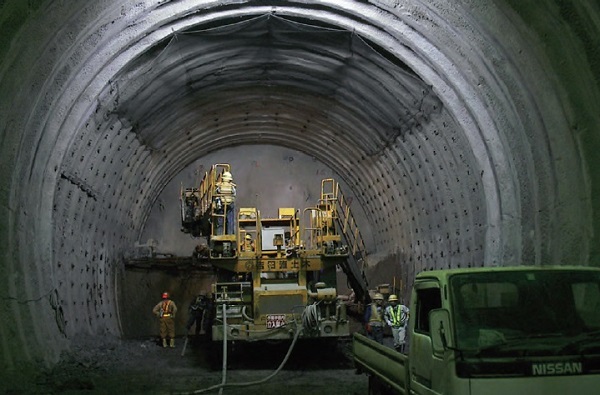 |
| ・Hokuriku Shinkansen Construction Bureau, Railway Construction Headquarters, Japan Railway Construction, Transport and Technology Agency ・TEKKEN, NISSAN RINKAIi, MORIYA Joint Venture ・Kumagai Gumi, JDC, OHOMOTO GUMI Joint Venture ・Hazama, KONOIKE, KAGATA, MARUYAMA Joint Venture ・Nishimatsu, TOA・UEKI, Nakamoto Joint Venture ・TAISEI, ZENITAKA, DAIICHI KENSESTU, Matsumoto-Doken Joint Venture ・OBAYASHI, DAIHO, MATSUMURA GUMI, Tanaka-Sangyou Joint Venture |
| Iiyama Tunnel, located on the Nagano-Niigata prefectural border, is 22.22 km long, the longest tunnel on Hokuriku Shinkansen and the third longest tunnel in Japan. In this project, safe tunneling technologies were developed. To reduce ground settlement in the areas of excavation in squeezing rocks, “multiple-layer supporting method” was devised. To carry out excavations easily with high groundwater pressure in unconsolidated ground, an advanced management method with three types of probe drilling and face ground evaluations was established. To safely excavate rocks containing flammable gases, appropriate gas detection and dilution systems were conducted |
[Group-2]
| 1. Speedy Restoration of Urban Expressway Viaducts Damaged by Severe Fire Accident |
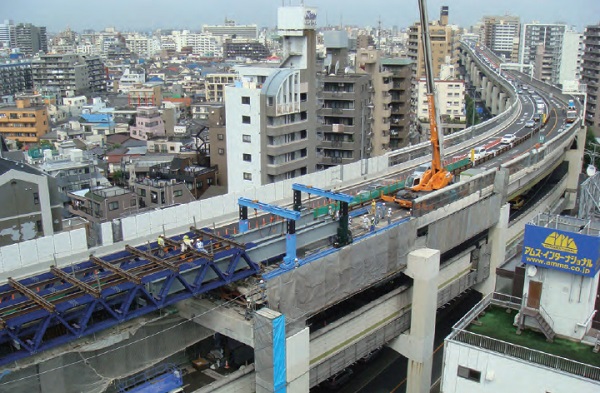 |
| ・Metropolitan Expressway Co., Ltd. |
|
On August 3, 2008 a tanker truck turned over and caused a severe fire on the double-decker viaducts of Metropolitan Expressway Route No.5 in Tokyo. Due to this fire accident, bridge structures such as steel I-shaped girders and RC slabs were deformed and the surface of the road caved in 70 cm as well. |
| 2. Nakanoshima New Line Construction Project- Subway Construction in Priority Area for Urban Regeneration in Osaka - |
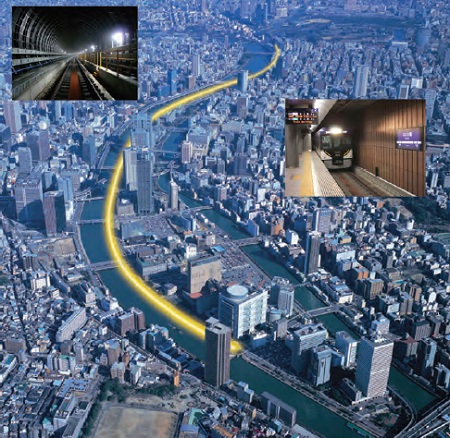 |
| ・Nakanoshima Rapid Railway Co., Ltd. ・Keihan Electric Railway Co., Ltd. |
| The purpose of Nakanoshima New Line Construction Project is to make railway networks more convenient for users, the number of who has increased in the redevelopment area, western Nakanoshima. This project introduced some approaches to ensure construction site safety because there were harsh ground conditions and important structures in the area. For example, we shared with information with all members of the construction unit and used new technologies. The construction site was located in the business district in the center of Osaka City. Therefore we made an effort to improve the landscape of the area more attractive and pleasant taking into consideration the environment. |
| 3. Construction of Hida Tunnel by Using TBM Method and Whole Line Opening of Tokai-Hokuriku Expressway |
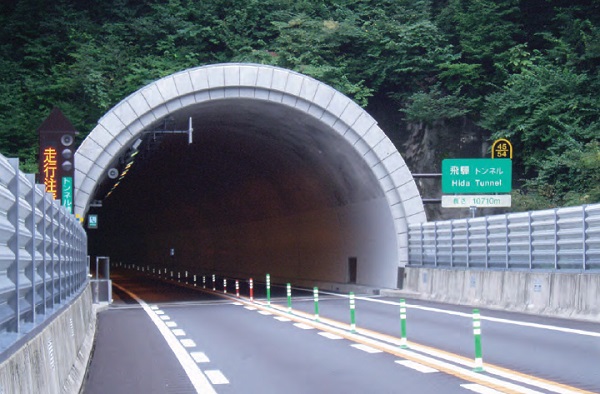 |
| ・Central Nippon Expressway Co., Ltd. |
| The whole line of Tokai-Hokuriku Expressway has been open to the public since its completion of the route between Hidakiyomi IC and Sirakawago IC in July 2008. As a result, the Hokuriku and Tokai areas have been connected directly, which will greatly contribute to the development of industries, economies and cultures in the areas. Hida Tunnel (length: 10.7 km) with the maximum overburden of 1040 m is the second longest road tunnel in Japan. TBM was adopted in tunnel excavation. The diameter of the TBM was 12.84 m, which was one of the largest in the world. Weak geological features and a large amount of spring water made construction of the tunnel very difficult, but no fatal accident occurred. This Hida Tunnel construction greatly contributes to the development of mountain tunnel technology in the future. |
| 4. Construction of Tokuyama Dam - Construction of the Largest Rock-Fill Dam in Japan and Creation of Beautiful Dam Lake that Co-Exists with Nature |
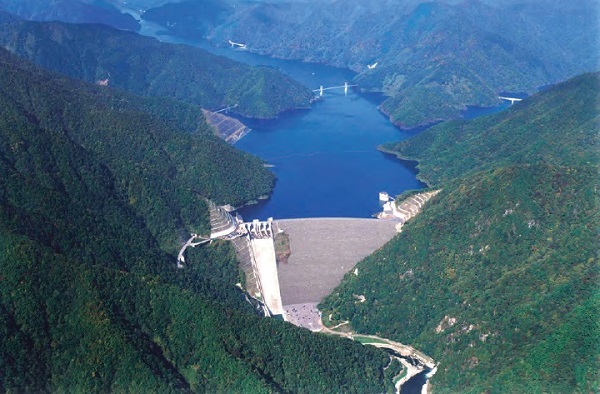 |
| ・Incorporated Administrative Agency Japan Water Agency |
| Tokuyama Dam located in Ibi-river, Kiso-river system is one of the largest rock-fill dams in Japan, which was constructed by Japan Water Agency in 2008. Various approaches such as "compilation of existing technologies and installation of new technologies for building the rock-fill dam" and "co-existing with nature" were taken, focusing on environmental preservation, shortening construction period and reducing construction cost. As a result, this project contributed to enhancing the civil engineering technology. The dam demonstrates the effective use of water resources, hydropower generation and flood damage reduction. |
| 5. Tokyo Bay Waterway Improvement Project- Challenging the Task of Removing Gigantic Structures in a Sea Area Congested by Passing Vessels - |
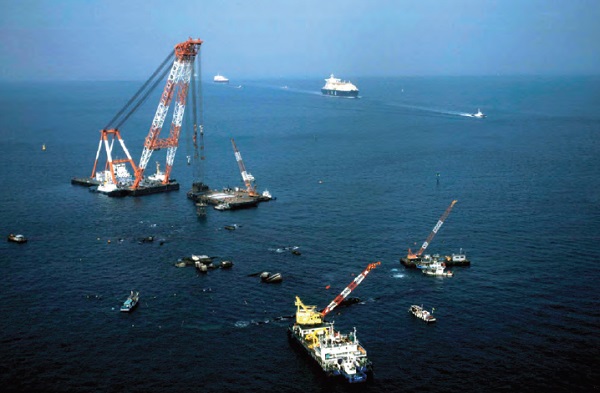 |
| ・Kanto Regional Development Bureau, Ministry of Land, Infrastructure, Transport and Tourism Liaison Council for Promotion of Tokyo Bay Waterway Project |
| This project involved the tasks of removing the ruins of Marine Fort No. 3 and dredging the bottom of the Nakanose waterway to the depth of 23 meters below sea level in order to enhance safety and facilitate the smooth passage of vessels sailing through the Tokyo Bay waterway. The project was conducted overcoming such diverse challenges as taking all measures necessary to ensure work safety in a congested sea area with passing vessels, coping with the impact of ship waves and tidal currents, and investigating and devising methods of clearing possible explosive materials and gigantic structures. It was an extremely important work to secure the safety of vessels passing through the Tokyo Bay waterway, a main artery of marine transport to support social and economic activities in the Tokyo metropolitan district. |
| 6. Fruition of the Urban Transport Network - Tokyo Metro Fukutoshin-Line- |
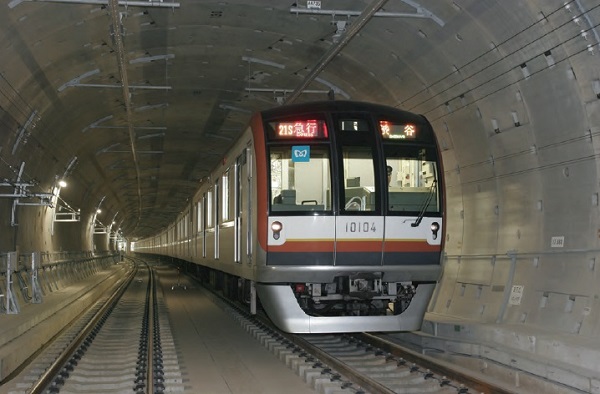 |
| ・Tokyo Metro Co., Ltd. ・Tokyo Metropolitan Government |
| The entire Fukutoshin Line opened in June, 2008, and the subway network in the Tokyo section was completed. In this section, seven stations were constructed between the starting point Shinsen-Ikebukuro station and Shibuya station. And the route from northwestern Tokyo and southwestern Saitama to Ikebukuro, Shinjuku, and Shibuya was secured. The construction of this route has greatly contributed to the development of the railway network in the central area of Tokyo, the culmination of subway construction technology, and the development of civil engineering technology and the development of society. |

